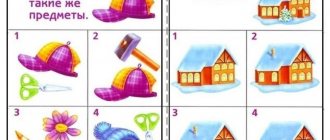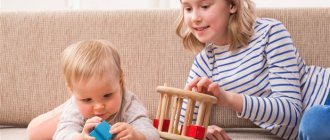Every parent dreams that their children are happy, smart, versatile, independent, that harmony reigns in the family, and that there are no difficulties with the process of raising or educating children. Maria Montessori's method, which has already become legendary, helps to solve all these issues and make the family truly friendly! In this article we will tell you how to follow this education system at home...
Surely many of the parents, especially mothers, have already heard more than once about the method of child upbringing, in which the child chooses the type of activity and its pace, and adults only observe the process and intervene only when absolutely necessary. The benefits of such joint activities with children are amazing! Children learn to be independent, make decisions, listen to themselves, take responsibility for their actions, and this brings joy to every family and, of course, unites it.
A little history: Maria Montessori, the founder of the method, teacher, began working with children who were behind in development. After a short period of work, her students, along with ordinary children, took part in the school Olympiad and took first place. After such a real pedagogical breakthrough, people started talking seriously about this great woman and her method, and Maria herself continued to improve her program for absolutely all children.
Also in support of the method, it is worth saying that many people famous throughout the world today were brought up according to the Montessori system. Among them are the founders of Google, Amazon and Wikipedia, the princes of the English royal family William and Henry, and the writer Gabriel Garcia Marquez.
So let's start exploring!
Personality Maria Montessori
This system of early child development is named after its author, the Italian doctor and teacher Maria Montessori, who first used her own developments to teach children with certain intellectual problems. Despite the fact that the proposed methodology was still at an early stage and represented only individual elements of the developmental environment, when working with students with disabilities, Montessori successfully prepared them for final exams in primary school, which they passed brilliantly. Then the teacher opened an educational institution “Children’s Home”, where she worked on the development of healthy children using her own methods. Maria Montessori has published several books that reveal the features of the organization of the educational and cognitive process according to her system, and has published a large number of publications that are used for the early development of children in kindergartens and development centers.
Human tendencies
Strictly speaking, the name of this concept established in the Russian language is not entirely accurate. The English word tendency means inclination, desire, and is much closer to the concept of “need” than to “tendency”. But the term has already become commonly used in literature, so I use it.
Instead of the desire to realize an instinct, a human cub is born with a desire for humanity:
- not yet able to communicate, he longs to communicate, needs connection with his own kind no less than food;
- Having extremely limited brain capabilities, he longs to know, think and understand, organize and understand what is happening around him;
- having almost no control over his own body, he already wants to improve himself and his capabilities, movements, wants and enjoys using his own body to explore the world;
- has powerful abilities for abstraction and imagination, a desire to perceive and create beauty, and a need to generate meaning.
At different periods of life, a person satisfies these needs-trends in different ways, at an accessible level. They are the motivational basis for development, personal activity, self-creation and self-improvement. The strings of desires guide the child’s activity. The more he acts, the more he learns. New opportunities allow you to follow your interest in a new way; desires give rise to actions, and actions give rise to skills, knowledge, habits, and personality itself.
An adult is able to independently take care of the implementation of trends and is able to change the world around him for this purpose. And the child needs competent support and a prepared environment, although he realizes them exclusively in his own activity.
The Montessori method of child development uses a hundred years of experience of its own practice and all the achievements of psychology and physiology related to child development. The method gives this knowledge to an adult so that he can design an extremely useful environment for a self-creating child. There are both general methodological guidelines and practical advice on how to implement the Montessori method at home.
Basic postulates of the Montessori system
When choosing development for your child using the Montessori method, you need to clearly know that its main postulate is to allow him to independently explore the environment with minimal help from an adult. Teachers call this technology “Help me do it myself.” Mom's opinion: When starting to study at a Montessori development center, it was a little strange that teachers, working with children, prefer not to interfere in the learning process until the little one asks for help or the need arises to intervene in a conflict situation.
This was a little unusual, because our upbringing is based on our own example, we need to show how to do it and ask the child to repeat it. And according to Montessori, the little one must understand how to interact with a game or a toy. Therefore, in groups, the teacher performs the functions of an observer to a greater extent, waiting for the child to turn to him.
Basic principles of training
The basic principle of Montessori pedagogy is, up to one year and older, not to force a child to do anything that he does not want himself. It becomes possible to carry it out thanks to the conditions that naturally develop in the Montessori system:
- every child strives for equal participation in life with adults;
- over time, children understand that this requires learning and gaining their own experience;
- also, kids soon realize that the more and faster they learn, the faster they can get into the adult world;
- The teacher takes a neutral position, does not show his attitude to this or that activity, but only provides assistance at the request of the child.
Basic rules for studying at a Montessori school
In groups, kindergartens, and schools that use this method, there are several basic rules that all students must adhere to, regardless of age. They allow you to streamline their activities, help everyone concentrate for a certain time only on their own activity, and not disturb others. In addition, children are taught order, discipline and respect for those working nearby.
The basic rules are:
- everyone deals with only one subject, you cannot take several toys;
- after playing with one game, the baby cannot take another one until he has placed the first one in a certain place;
- You can’t take away games from other children, you need to wait until the little one puts the toy in its place;
- You can run, scream, and play noisily after class in a room specially designated for this; some especially impatient children are allowed to run around during the lesson.
By studying in such groups, the child involuntarily learns to respect other people, their rights, and, at the same time, clearly define his comfort zone, preventing aggression directed in his direction. Mom's opinion: We liked that in classes the teachers teach the baby to stop the aggression of others by saying “No!”
while simultaneously putting your hand forward with your palm open. "No! I’m still playing this game, I can’t take it away.” Then, in the yard, in the garden, the cub also stopped overly active children, without allowing himself to be offended.
What does this type of education give to children?
Classes according to the Montessori system allow children to realize their natural cognitive interests at their own pace and rhythm. Unlike traditional classes, in the Montessori environment for the little ones it is almost never boring or uninteresting; here everyone finds materials and games to their liking. The system perfectly develops independence; a very small child can already sweep the floor or wash small items.
How are Montessori early childhood schools organized?
The basic rules for organizing classes using this technology are the same for all educational institutions:
- A specially organized space is required for classes. The room is divided into several zones by shelving. If the size of the room allows, the racks are installed along the walls, in the middle. Various aids are placed on them: educational toys, logic games, construction sets, and other materials, depending on the age of the children for whom the zone is designed and the degree of their preparation.
- Children of different ages are recruited into groups for classes. Usually they combine 1-3 year olds, 3-6 year olds, some centers offer so-called late development classes for 7-9 year olds. Being in groups of different ages, younger children follow the older ones and strive to repeat everything they do. Older children take care of the younger ones and help them. It is very important that the teacher who conducts the classes focuses on caring for the younger ones and praises the older ones for their attention.
- The teacher does not interfere in the child’s learning process, does not impose games, and only intervenes in conflict situations, when the child asks for help or when it is necessary to reason with an overly naughty toddler.
Playing space zones
The room in which classes are held using this method is divided into several zones, depending on the direction of the sphere of cognition.
So, they distinguish:
- Practical or household area. By playing with objects here, the baby will be able to learn the simplest skills of cleaning, dressing, fastening buttons, various types of locks, that is, what he will have to do independently at home and in the garden. For the little ones you can find a dustpan, a broom, buttons, eyelets, Velcro, zippers, flour, a sieve, water, a glass. Having mastered the skills of dressing and fastening in a game, on dolls, the baby will be able to use them in everyday life, these actions will no longer pose difficulties for him.
- Sensory. Here are various objects that differ in shape, color, weight, sound, and surface structure. These can be jars, cream tubes of various sizes, sets of lids, jars. An excellent trainer for the development of auditory perception can be identical tubes with different fillers (sand, peas, pebbles), which sound differently when shaken. The child’s task is to sort out all the lids and jars, then match pairs and find identical sounding objects. In such a game, he simultaneously receives tactile and auditory sensations, trains fine motor skills, memory and attention.
- Mathematical. The main task here is to introduce the baby to geometric shapes, numbers, and show how to count objects. For small children there are various inserts with mathematical elements, wooden sets of geometric figures, for older children - abacus, sets of whole and divided objects for learning fractions.
- Language. Here the child can play with letters made of wood and plastic, look at various books, pictures, voice animals, match pictures from the sets “Who is this?”, “What is this”?”, “Who says what?”.
- Space. The games presented in it give concepts about the environment around us, the structure of the Earth, the Universe, nature, and other peoples. This area is intended for older children, from 5-6 years old. For kids to begin to get acquainted with the world, at first, toy animals and imitation of their habitat are enough.
Create the conditions!
For your child, everything in this world still seems huge: chairs, cabinets, tables, beds. He is like Gulliver, who found himself in the land of giants. Is it possible for him to learn something this way? Here every little one feels lost and helpless. Your task is to correct this and create an accessible environment for the child, so that everything he needs for a full life is nearby. We will create special zones for this.
For the harmonious and proper development of babies, several zones are needed that fathers and mothers can create themselves:
- an area of everyday life in which he will have access to everything he needs daily (hangers for clothes, towels, toothpaste, soap, etc.);
- a language development zone, which may contain bright books, cubes with letters, pencils, paper, numbers and letters cut out of thick paper;
- a creativity zone in which the child will have paints, musical instruments, plasticine, pencils, paper and everything that is needed for children's creativity;
- natural science zone, here you need to put everything that will tell the child about the outside world: figures and pictures of animals, flowers, different liquids, objects with different temperatures, etc.;
- a zone of sensory development, in which the baby will be greeted with objects of different shape, content, smell, and structure. These can be cubes, cylinders, cereals, various fabrics, etc.;
- an activity zone, which can become a children's sports corner.
All these zones do not take up much space, do not interfere with normal life and will fit even in a small semi-detached or studio room. Simply put, zones are properly arranged children's things and toys. And now first things first!
How development technology changes for different children's ages
Depending on the age of the children, special emphasis in organizing the play space is placed on one or another zone. So, for children under 3 years old, tactile, color, and auditory perception are especially important, so in the practical and sensory zone there are as many games and objects as possible, and in the language zone there may just be a few books with unusual prints or covers. Experiencing a crisis at the age of three, the toddler “searches” and “gets to know” himself and begins to separate his personality from his parents. Therefore, at this age, it is important that the play space provides as many opportunities as possible to show independence, to understand for oneself how to interact with this or that object. Objects that are present in the lives of older brothers and sisters - school boards, chalk, sponges, various rulers with complex geometric shapes - are of active interest. The development of older children, from 6 years old, should be aimed at understanding the Universe, the outside world, other cultures, the life of other nationalities, therefore the Space Zone is expanding. Now new zones are appearing in Montessori groups: musical development, art, motor, creativity. The technique does not stand still, it develops.
How to create a developing environment for a child?
For wise parents, the Montessori method of teaching children works even without special devices: the child is given a broom, rag, sponge for washing dishes or a vacuum cleaner when he asked for it and decided to do it himself. It is worth allowing the child to fully participate in the everyday life of the family.
If you want to create a classic developmental environment for a child, then the main thing to do is to divide the playroom into zones: mathematical, space, language, sensory and practical. All games and toys should be located so that the child can pick them up independently and put them back after the lesson is over.
Sensitive periods
If human tendencies are inherent in a person at any age, then sensitive periods are temporary. Maria Montessori wrote about them this way: “We are talking about a special sensitivity in development that occurs at an early age in living beings. It has a limited duration and serves to make it easier for a living being to master any skill or ability. As soon as a child masters a skill, the corresponding type of sensitivity disappears.”
The sensitive period has two sides:
The internal one manifests itself in the vital impulse to any activity. External is an observable interest in activities and activities, in gaining experience of a certain kind: repetition, concentration, and obvious satisfaction from work instead of fatigue.
It is important for parents and teachers to know the types of sensitive periods and the approximate timing of their onset. It is also necessary to be able to recognize moments when a child is overwhelmed by passion and follows the path of development at his own pace. Montessori trains adults to be gentle helpers who are able to provide what is needed in a timely manner and to step back in time, allowing the child to act independently. This develops new qualities in the child and the ability to act thoughtfully and focused, and forms an understanding of oneself as a successful person.
The sensitive period is like a spotlight, attracting the viewer’s attention and illuminating to the smallest detail the most important thing at this moment of the performance. But the performance goes on as usual, and anyone who is distracted and not looking at the stage will miss something important. Sensitive periods fade over time, even if the developmental tasks they provide have not been solved.
Unfavorable passage of sensitive periods does not always lead to obvious deformation of mental life. But it greatly affects future opportunities and the quality of growing up, and it is important for an adult to prevent such a development of events. For some fundamental things, the time lost can be dramatic. The experience of Mowgli children shows that a person is not able to fully master speech after the sensitive period of speech development is completed.
Montessori offers following the child as a universal way to individualize a personal educational trajectory. If we allow him to choose for how long and what exactly he will do in a prepared environment, then he will learn everything at the most appropriate moment for himself. And bring the solution to each task to the end, leaving no undeveloped moments.
conclusions
Today we introduced you to the Montessori development method for children under one year old. As you can see, the activities do not require much effort, but have a significant impact on the child's development.
First of all, make sure that your baby has a comfortable area to sleep and study, and that mom and dad are nearby and talk to the baby as often as possible. After this, select suitable educational Montessori materials for your baby, but remember, children from 0 to one year develop differently, so activities should be selected based on the child’s interests. Don’t worry if your baby is slightly behind the monthly breakdown we suggested; in just a few weeks he will most likely catch up with his peers.











